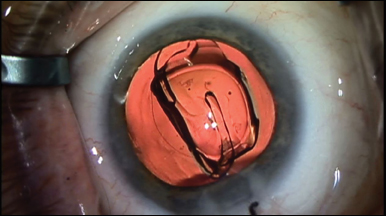Preloaded IOL injectors for microincisions increase efficiency, safety
A surgeon explains how he uses the Tecnis iTec to insert and position the lens.
Cataract surgery continues to evolve and advance in terms of technology, along with improved techniques, to offer a final result of augmented visual quality and faster visual recovery for our patients, thus quickly returning them back to their normal activities. Femtosecond laser technology helps to soften the nucleus along with a reproducible, precise capsulorrhexis and corneal incisions. Premium IOLs address presbyopia and astigmatism correction, while smaller corneal incisions limit or decrease induced corneal astigmatism. All of these modalities have significantly improved cataract surgery.
IOL delivery into the eye is an important step in cataract surgery. The method of IOL deployment has continued to advance and now offers the surgeon both manual IOL loading into the cartridge and preloaded IOL injectors that are microincision-friendly. These newer preloaded IOL injectors enhance microbiological safety by avoiding potential contamination in the operating room, eliminate the mechanical loading step, thus saving surgical time, and improve reproducibility of overall IOL delivery.
The first preloaded lens in the U.S., the iSert (Hoya), was introduced in 2009. Subsequently available are the AcrySert C (Alcon) and the Tecnis iTec (Abbott Medical Optics). Other advances are adding automation to IOL delivery, such as with the Intrepid AutoSert (Alcon) and the Bausch + Lomb Injector System (BLIS). Manual delivery includes a screw mechanism plunger that requires the use of two hands with controlled IOL delivery, and a plunger mechanism that can be used as a one-handed technique with less controlled IOL delivery. Factors that influence IOL passage include intra-cartridge frictional resistance and IOL gliding ability for a smooth delivery. Clearly, cataract surgery continues to improve in all areas, with a bright future for improved vision and a happy patient.
In this column, Dr. Koch highlights the welcome addition of preloaded IOL injectors for microincision cataract surgery and describes his surgical technique using a preloaded IOL injector.
Thomas “TJ” John, MD
OSN Surgical Maneuvers Editor

We know that cataract incisions 2.4 mm and smaller typically induce minimal astigmatism. My data show mean surgically induced astigmatism of 0.13 ± 0.30 D. However, inserting a lens through these smaller incisions has presented a bit of a challenge. Preloaded injectors that fit through microincisions have not been available, so lenses had to be removed from the case, placed inside some sort of cartridge and then loaded into an insertion device so that they could be placed in the eye. Compared with much of what we do in ophthalmology, this routine is rather archaic, and it seems obvious that preloaded injectors are the future of IOL delivery.
Preloaded injectors provide a number of benefits, including making the procedure safer by reducing the possibility of endophthalmitis from contamination and avoiding potential mistakes such as loading the lens incorrectly. It is certainly more efficient for the nursing or technical staff who no longer have to load the lenses, as well as for the surgeon. For surgeons who rely on intraoperative aberrometry to make the final lens selection, it is particularly nice to have two or three options available and preloaded in their injector to minimize delays once the final lens selection has been made.


Images: Koch DD




A new preloaded injector capable of fitting through a microincision is the Tecnis iTec preloaded delivery system (Abbott Medical Optics), which passes through a 2.2- to 2.4-mm incision across the entire dioptric range (5 D to 34 D). The Tecnis iTec has a screw mechanism, rather than a plunger, which allows smooth, controlled delivery into the eye. This provides consistent loading and deployment, with minimal variability between surgeries. In my experience, the lens unfolds more rapidly than with a standard platinum injector, speeding up the surgery slightly. In addition, it has a planar delivery path, meaning that you point the injector where you want the lens to go. The injectors are latex-free and not reusable.
Technique
Figures 1 through 3 show use of the iTec preloaded injector. After aspirating the cortex, I inject a cohesive viscoelastic into the anterior chamber angle on each side of the incision, which pushes the dispersive viscoelastic into the center of the eye where it is easy to aspirate after the lens has been implanted. Next, the scrub tech hands me the injector, and I use a second instrument in my left hand to stabilize the eye.
The injector is inserted and positioned appropriately, and then my left hand turns the screw mechanism to gently deliver the lens into the capsular bag. The tucked haptics unfold while the viscoelastic is being removed, and the lens positioning is complete.
Currently, the other preloaded injectors available in the U.S. are the AcrySert C (Alcon), which is designed to implant the AcrySof IQ IOLs (Alcon), and the Hoya iSert, which is used in conjunction with the Hoya models 250 and 251. The development of a preloaded injector for the Tecnis line of lenses is a great addition for cataract surgeons aiming to increase efficiency and precision in surgery.
- Reference:
- Masket S, et al. J Refract Surg. 2009;25(1):21-24.
- For more information:
- Douglas D. Koch, MD, can be reached at Cullen Eye Institute, Baylor College of Medicine, 6565 Fannin, NC205, Houston, TX 77030; email: dkoch@bcm.tmc.edu.
- Edited by Thomas “TJ” John, MD, a clinical associate professor at Loyola University at Chicago and in private practice in Oak Brook, Tinley Park and Oak Lawn, Ill. He can be reached at tjcornea@gmail.com.
Disclosures: Koch reports he consults for Abbott Medical Optics and Alcon. John reports no relevant financial disclosures.
